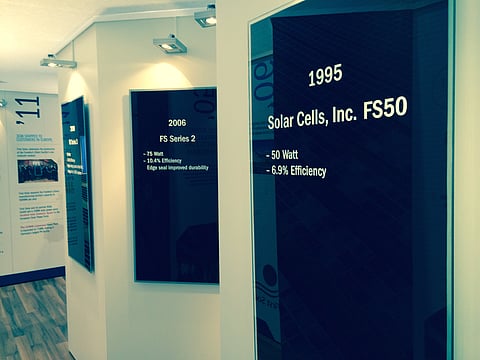

First Solar is one very good example of a PV maker that not only has an ambitious technology roadmap in place, but has been reaching its milestones. The Cadmium Telluride (CdTe) thin film PV maker has devised a technology roadmap in 2013 and revised it upward in March 2014. According to the latest roadmap, the US company was expected to reach a milestone efficiency of 22% at the research cell level by end of 2015. It waited for publication of its fourth quarter results, but on Feb. 23, First Solar announced a research cell efficiency of 22.1%, certified at Newport Corporation's Technology and Applications Center (TAC) PV Lab. According to the company, it is a new world record for a CdTe thin film PV device, succeeding the previous record of 21.5%, which was also set by First Solar about a year ago. As in the past, the current record research cell was also built using processes and materials suitable for commercial-scale manufacturing.
Lonesome CdTe supporter
While silicon thin film technologies have failed in the market, CdTe PV technology, together with CIGS, are the only potential commercial alternatives to traditional crystalline technology. But CIGS hasn't improved efficiencies much in the last 5 years – only increasing 2%pts from 20.3% in 2010 to 22.3% as announced in December 2015, although several international institutes and companies are working on CIGS technology. On the other hand, CdTe, which is being developed by only one company, First Solar, improved its top cell's absolute efficiency from 17.3% in 2011 to the current level of 22.1%.
Efficiency improvements at various levels
First Solar has made tremendous progress in improving the efficiency of its products at various levels. According to the press release, the current world record is the 9th substantial update for CdTe technology since 2011, including progress at the cell as well as module level. At the cell level alone, this is the 6th significant efficiency improvement – from 17.3% in mid 2011. First Solar has also been successfully transforming this progress at the research level into larger module substrates and then eventually into commercial production. The record level module performance of 13.4% in 2011 has been improved progressively to 18.2%, as announced in July 2015. The average module efficiency of 11.7% at the end of 2011 has been improved to 14% by the end of 2014. The leading manufacturing lines of the company were producing PV modules with 16.4% conversion efficiency in fourth quarter of 2015.
What's next?
These achievements are inline with its latest technology roadmap, set by the company in April 2014. According to the roadmap, module efficiency of 16.5% was planned for end of 2015, which has been nearly achieved; the target for the next 2 years was set at 18% and 19.5%, respectively. As mentioned above, the progress at the reach cell level has met the roadmap goals, while 1% absolute rise is expected for each of the next 2 years.
It is difficult to say, if the US module maker is a little behind at the module research stage or just saving the news for the next quarterly results. According to the roadmap, full area module efficiency was supposed to hit 18.8% by end of 2015, 19.4% during this year and reach 20.2% by end of 2016. The last announcement from the company regarding full area module efficiency was 18.2% in June 2015. But if the past is any indication for the future, First Solar will stick to its ambitious roadmap as planned.
.png?w=50&fm=png)